Table of Contents
CBSE Sample Papers for Class 12 Economics Delhi – 2016
Time allowed : 3 hours Maximum marks 100
GENERAL INSTRUCTIONS
- All questions in both the sections are compulsory.
- Marks for questions are indicated against each.
- Questions No. 1-5 and 17-21 are very short-answer questions carrying 1 nick each. They are required to be answered in one sentence each.
- Questions No. 6-10 and 22-26 are? short-answer questions carrying 3 marks each. Answers to them should normally not exceed 60 words each.
- Questions No. 11-13 and 27-29 are also short-answer questions carrying 4 marks each. Answers to them should normally not exceed 70 words each.
- Questions No. 14-16 and 30-32 are long-answers questions carrying 6 marks each. Answers to them should normally not exceed 100 words each.
- Answers should be brief and to the point and the above word limit should be adhered to as far as possible.
SET I
SECTION A
Question. 1 What is the relation between marginal cost and average variable cost when marginal cost is rising and average variable cost is falling?
Answer. When marginal cost is rising and average variable cost is falling, marginal cost lies below the average variable, cost i.e., MC < AVC.
Question.2 Suppose total revenue is rising at a constant rate as more and more units of a. commodity are sold, marginal revenue would be: (choose the correct alternative)
(a) Greater than average revenue
(b) Equal to average revenue
(c) Less than average revenue
(d) Rising 1
Answer. (b) Equal to average revenue.
Question. 3 When does ‘increase’ in demand take place?
Answer. When demand for a good increases with a change in factors other than the price of the good, increase in demand takes place. The other factors may be increase in price of substitute goods, fall in price of complementary good, increase in income of consumer etc.
Question. 4 ‘Homogeneous products’ is a characteristic of: (choose the correct alternative)
(a) Perfect competition only
(b) Perfect oligopoly only
(c) Both (a) and (b)
(d) None of the above
Answer. (c) Both (a) and (b).
Question. 5 There is inverse relation between price and demand for the product of a firm under: (choose the correct alternative) ,
(a) Monopoly only
(b) Monopolistic competition only
(c) Both under monopoly and monopolistic competition
(d) Perfect competition only
Answer. (c) Both under monopoly and monopolistic competition.
Question. 6 A consumer consumes only two goods X and Y. Marginal utilities of X and Y are 5’and 4 respectively. The prices of X and Y are Rs 4 per unit and Rs 5 per unit respectively. Is the consumer in equilibrium? What will be the further reaction of the consumer? Explain.
Answer.
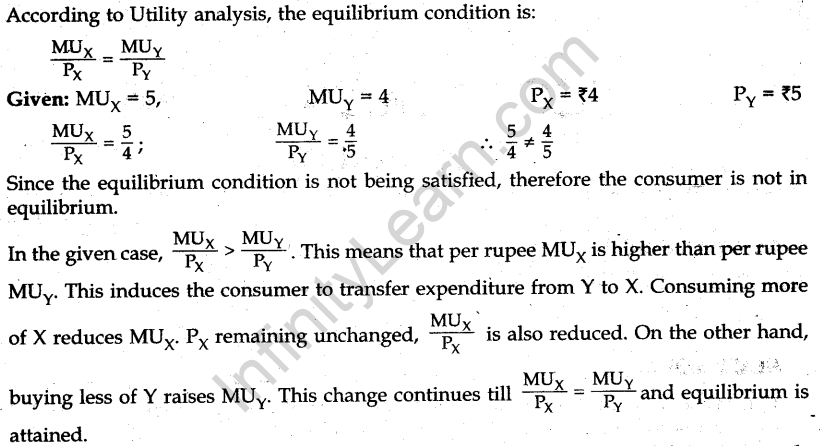
Question. 7 Price elasticity of demand of good X is -2 and of good Y is -3. Which of the two goods is more price elastic and why?
Answer. Due to negative relationship between price and demand, elasticity of demand has a. negative sign. But, for the purpose of comparison of price elasticity of demand of two goods, the absolute value is taken. -2 and -3 are the actual Values of the price elasticities of the two goods. But on comparing the two, -3 is taken to be greater than -2 as we consider the absolute values. Therefore, Good Y is more price elastic as compared to Good X.
Question. 8 What is Maximum Price Ceiling? Explain its implications.
Answer. Maximum price ceiling refers to imposition of upper limit by the government on the price of a good that can be Charged by a seller. The government usually fixes this price at a level lower than the equilibrium price so that it is within the reach of the poorer sections of society. For example, in the diagram, OP is the price ceiling which is less than the equilibrium price OPr At this price, the producers are willing to supply only PA (or OQ1) quantity of the goods while consumers demand PB (or OQ2) quantity.
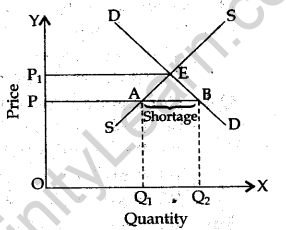
The demand becomes higher than supply and this leads to shortage (equal to AB or Q1Q2) in the market which may further lead to hoarding and black marketing. This situation of black marketing can be solved by introducing the system of rationing.
Or
Explain the chain effects, if the prevailing market price is below the equilibrium price.
Answer. In the given diagram, demand is equal to supply at the equilibrium market price OP. Suppose, price falls to OP1. If the prevailing market price is below the equilibrium price, a situation of excess demand (SJDJ) emerges. In this situation, consumers will riot beadle to buy all what they want. It will lead to competition among consumers. They will start offering a higher price to the suppliers. At a higher price, suppliers will be willing to supply more. The price will start moving upwards along the demand curve (contraction) and supply curve (extension), as indicated by the arrows, till it reaches OP at E (equilibrium level).
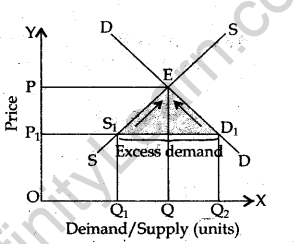
Question. 9 Explain the effect of change in prices of the related goods on demand for the given good.
Answer. The effect of change in prices of the related goods on demand for the given good can be studied as under:
(a) Substitute Goods. Substitute goods are those goods which can be used in place of one another. For example, tea and coffee. An increase in the price of a substitute good (say tea)causesSn increase in demand for the given good (coffee) and shifts the
demand curve to the right. This is because the product (coffee in this case) becomes cheaper in comparison to its substitute (tea in this case).
Similarly, a decrease in the price of the substitute will decrease the demand of the given good leading to a leftward shift in the demand curve of the given good.
Question.10 Define Production function. Distinguish between short run and long run production functions.
Answer. The functional relationship between physical inputs and physical output of a commodity is called Production function.

Or
Define Cost. Distinguish fixed and variable costs. Give one example of each.
Answer. Cost is the total expenditure incurred in producing a commodity. It is the sum-total of explicit costs and implicit costs.
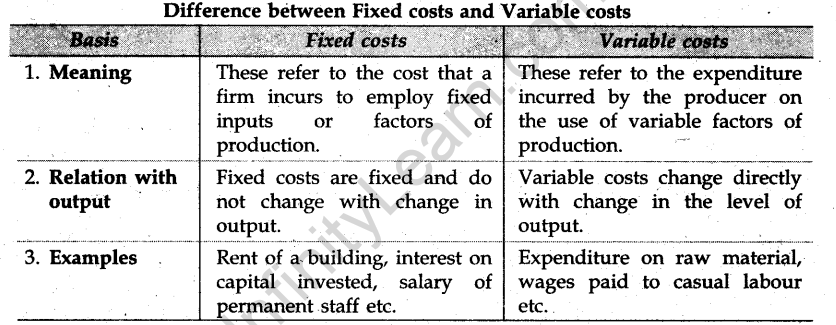
Question. 11 A producer supplies 80 units of a good at a price of Rs 10 per unit. Price elasticity of supply is 4. How much will he supply at Rs9 per unit?
Answer.

Question. 12 Assuming that no resource is equally efficient in production of all goods, name the ‘ curve which shows production potential of the economy. Explain, giving reasons, its properties.
Answer. Production Possibility Curve (PPC) is the curve showing the production potential or the alternate production possibilities of two goods in an economy with given resources and technique of production assuming full and efficient utilization of these resources. . Properties of PPC are as follows:
(i) PPC slopes downwards. PPC slopes downwards from left to right. This is so
because to produce more quantity of one good the society has to sacrifice some quantity of the other good. The reason being that resources are limited.. ,
(ii) PPC is concave to the point of origin. The PP curve is concave because marginal rate of transformation (MRT) which is the slope of PPC, increases continuously as more and more of one good is produced by reducing the quantity of the other good. It means that to produce more and more units of one good each time, the quantity of the other good is sacrificed at an increasing rate. MRT increases because no resource is equally efficient in production of all goods.
Question. 13 Explain the conditions of consumer’s equilibrium using indifference curve analysis.
Answer. See Q. 14, 2014 (Comptt. I Delhi).
Question. 14 Explain the distinction “change in quantity supplied” and “change in supply”. Use diagram.
Answer. Difference between change in quantity supplied and change in supply
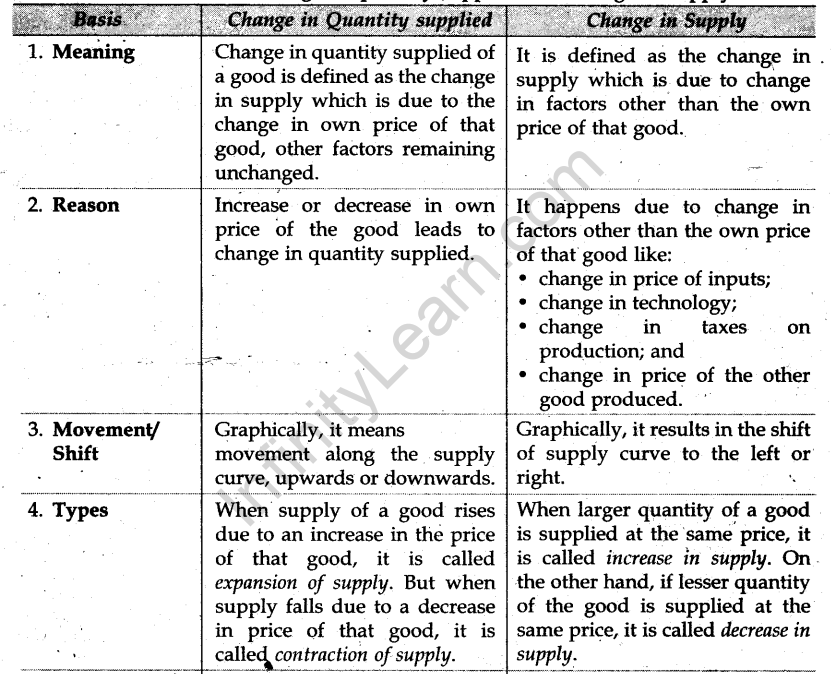
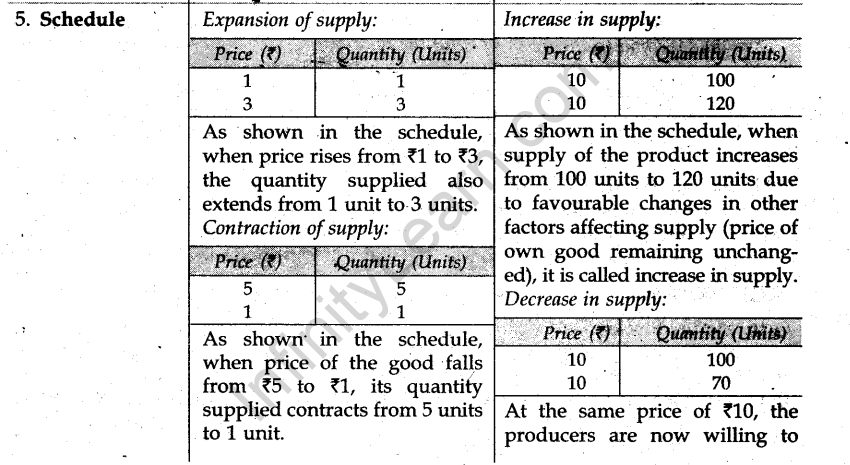

Note: For BLIND CANDIDATES in lieu of Q. No. 14.
Explain the distinction between “change in quantity supplied” and “change in supply”. Use schedule.
Answer. Same as Q. 14 (above).
Question. 15 Explain the implications of the following in a perfectly competitive market:
(a) Large number of buyers (b) Freedom of entry and exit to firms
Answer. Following are the two important features of a perfectly competitive market:
(a) Large number of buyers. See Q. 7, 2015 (I Delhi). [Page 321
(b) Freedom to the firms to enter the industry. Under perfect competition firms have the freedom to enter the ihdtistry. As a result of this, existing firms which are earning abnormal profit will cease to earn that. New firms entering the industry will increase the supply of the product by lowering the price, heading to a situation where a firm earns only normal profit. This means price will be the same for all the firms.
Or
Explain the implications of the following in an oligopoly market:
(a) Inter-dependence between firms (b) Non-price competition
Answer. (a) Inter-dependence between firms. See Q. 8, 2015 (Comptt. II Outside Delhi). [Page 370
(b) Non-price competition. See Q. 8, 2015 (II Outside Delhi).
SECTION B
Question. 16 Define Stocks.
Answer. Stocks are variables whose magnitude is measured at a particular point of time. For example, capital invested as on 31st March, 2015 by a firm.
Question. 17 Depreciation of fixed capital assets refers to: (choose the correct alternative)
(a) Normal wear and tear (b) Foreseen obsolescence
(c) Normal wear and tear and foreseen obsolescence
(d) Unforeseen obsolescence
Answer. (c) Normal wear and tear and foreseen obsolescence.
Question. 18 What is Revenue Expenditure?
Answer. Revenue expenditure of the government is that expenditure which neither creates any asset nor does it lead to any reduction in liability.
Question. 19 Fiscal deficit equals: (choose the correct alternative)
(a) Interest payments (b) Borrowings
(c) Interest payments less borrowing (d) Borrowings less interest payments
Answer. (b) Borrowings
Question. 20 Foreign exchange transactions dependent on other foreign exchange transactions are called (choose the correct alternative)
(a) Current account transactions (b) Capital account transactions
(c) Autonomous transactions (d) Accommodating transactions
Answer. (d) Accommodating transactions.
Question.21 Find Net Value Added at Factor Cost:

Answer.

Question. 22 Distinguish between marginal propensity to consume and average, propensity to consume. Give a numerical example
Answer. Difference between marginal propensity to consume and average propensity to consume:

Or
Explain the role of taxation in reducing excess demand.
Answer. Excess demand refers to the situation when aggregate demand is in excess of aggregate supply i.e., (AD > AS) corresponding to full employment in .the economy.
To reduce excess demand, the government under its fiscal policy measures can increase the tax burden on households and producers. This will reduce the purchasing power in the economy and hence reduce aggregate demand.
Question. 23 In an economy investment is increased by Rs 300 crore. If marginal propensity to consume is 2/3, calculate increase in national income.
Answer.

Question. 24 Government incurs expenditure to popularize yoga among the masses. Analyse its impact on gross domestic product and welfare of the people.
Answer. By trying to popularize yoga among the masses, the government is trying to create health awareness. It is also trying to get people to adopt a healthy lifestyle. This, in the long run, will benefit both the society and economy. Adoption of healthy habits will raise the physical and emotional welfare of the people. A healthy and fit workforce will have a positive impact on the gross domestic product (GDP) of the country. Improvement in health and increase in fitness levels will lead to improved productivity arid efficiency of workforce along with greater stamina to work and reduced absenteeism. This in turn will increase the GDP of the country, i.e., higher availability of goods and services per person. This will further increase the welfare, of people.
Question. 25 Explain the ‘Store of Value’ function of money. How has it solved the related problem created by barter?
Answer. Store of Value. Store of value means storing of wealth for future use. Money as a store of value means that an individual can save his earnings until the time he wants to spend the same. Storing wealth has become considerably easy with the introduction of money. This is because money comes in convenient denominations, it is easily portable and can be easily exchanged for goods at’ alHimes. It is also a very economical and convenient way of storing wealth.
In the barter system, no goods served as convenient assets for use in future. For storing purpose the good must be non-perishable, easily portable and readily acceptable for exchange at any time with other goods. All these features were found in money which helped overcome this particular limitation of barter system.
Or
Explain the ‘Unit of Account’ function of money. How has it solved the related problem created by barter?
Answer. Unit of Account. Unit of account means that the value of each good or service is measured in monetary unit.
The main difficulty that arose in the barter system was that at what rate any exchange should be made? In the absence of a common unit of value, the price of each commodity had to be quoted in terms of all the other commodities available in the market. The price list, thus, became extremely complicated.
Introduction of money overcame this problem. Money became a powerful medium of comparing prices of goods and services. It became the standard unit of measurement in terms of which the value of all goods and services are being measured and expressed (known as price). It is treated as the standard unit for borrowing and lending activities. It has also made possible the keeping of business accounts and thus facilitated trade.
Question. 26 Explain how open market operations are helpful in controlling credit creation.
Answer. See Q. 29, 2013 (II Outside Delhi).
Question. 27 What is Government budget? Explain how taxes and subsidies can be used to influence allocation, of resources.
Answer. A government budget is a statement showing item-wise estimated receipts and expenditures of the government under various heads during a given financial year.
The government tries to influence economic life through its budgetary measures like taxes and subsidies. Reallocation of resources is an important objective of government budget.
Allocation of resources. In market economies allocation of resources is determined by the forces of demand and supply. Resources are allocated to the production of those goods which earn high profits ignoring social welfare. The government corrects or reallocates the resources throughTits taxation policy to maintain a balance between social welfare and economic welfare.
(i) Government discourages the production of harmful consumption goods (like liquor, cigarettes etc.) by imposing high taxes.
(ii) Tax concession and subsidies are given to encourage the production of essential goods such as food grains, kerosene etc.
(iii) The concessions and subsidies are also given to encourage productive activities in backward areas.
Or
Define Revenue receipts in a government budget. Explain how government budget can be used to bring in price stability in the economy.
Answer. Revenue receipts of the government may be defined as those money receipts which do not create a liability for thq government and neither do they lead to a reduction in assets of the government. These include tax and non-tax receipts, duties and fines, interest and dividend receipts on government assets and investments.
The government budget is used to prevent economic fluctuations. Economic fluctuations refer to the situations of inflation or deflation. Such fluctuations create uncertainties in the economy. Absence of large scale fluctuation in prices promote economic stability. Government can exercise control over these fluctuations through taxes and expenditure. For example, in inflationary situation, government can discourage spending by increasing taxes and at the same time reduce its own expenditure. In times of depressed conditions, government can encourage spending by giving tax concessions, subsidies etc. and at the same time increase its own expenditure.
Question. 28 Given Consumption Curve, derive saving curve and state the steps taken in the process of derivation. Use diagram.
Answer. Saving function refers to the functional relationship between saving and income. Consumption and Saving curves are complementary curves as they together make up Income. Therefore, the saving curve can easily be derived from the consumption curve. Total Income = Consumption expenditure + Saving. Consumption is the function of Income. However, some consumption is always there even if there is no income, i.e., at zero level of income. This is called autonomous consumption.
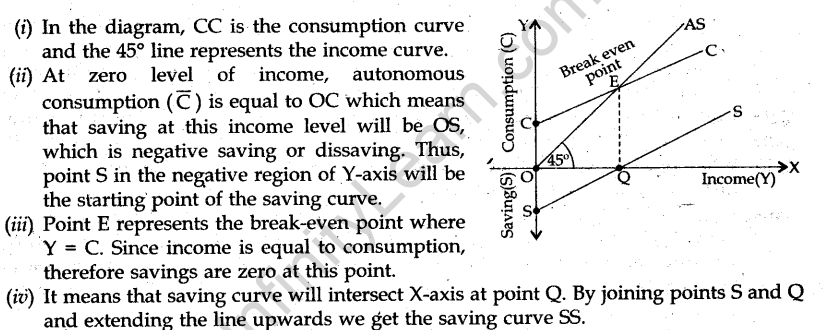
Note: For BLIND CANDIDATES in lieu of Q. No. 28.
Explain the components of consumption function. Derive saying function from consumption function
Answer. Consumption function refers to the mathematical relation between consumption expenditure and income.
This relationship can be expressed in the form of an equation in the following way:

Question. 29 (a) In which sub-account and on which side of balance of payments account will
foreign investments in India be recorded? Give reasons.
(b) What will be the effect of foreign investments in India on exchange rate? Explain.
Answer. (a) Foreign investments in India will be recorded on the credit side of Capital Account of BOP indicate by the positive sign. This is because Borrowings and Investments involving the rest of the world are the two principal components of Capital Account of BOP. Also, inflow of foreign exchange or receipts from the rest of the world are recorded as credit.
(b) Foreign investments in India will increase the supply of foreign currency. This will lead to decrease in the exchange rate which implies that domestic currency appreciates in relation to the foreign currency.
Question. 30 Find national income and private income:
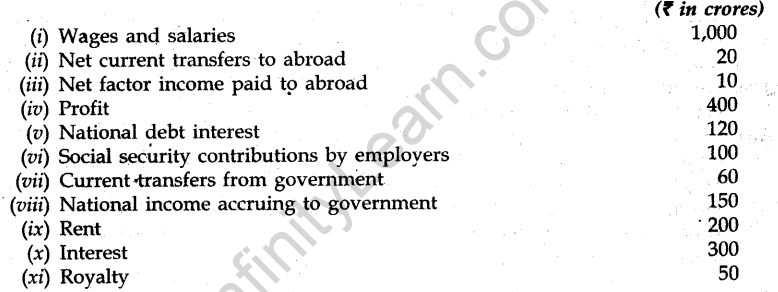
Answer.

SET II
Note: Except for the following questions, all the remaining questions have been asked in Set-I.
SECTION A
Question. 4 When does ‘increase’ in supply take place?
Answer. Increase in supply takes place due to a favourable change in factors other than own price – of the commodity.
Question. 5 What is the relation between marginal cost and average cost when average cost is constant?
Answer. Average Cost (AC) is constant when it is at its minimum and at this point MC = AC.
Question. 7 A consumer consumes only two goods X and Y. If marginal utilities of X and Y are 4 and 5 respectively, and if price of X is Rs 5 per unit and that of Y is Rs 4 per unit, is the consumer in equilibrium? What will be further reaction of the consumer? Explain.
Answer.

Question. 9 Price elasticity of supply of good is 2. A producer supplies 100 units of a good at a price of Rs 20 per unit. At what price will he supply 80 units.
Answer.

Question. 10 Explain the effects of change in income on demand for a good
Answer. Demand for a commodity is also affected by change in income of the consumer. The effect of change in income on the demand depends on the type of good.
(i) Normal goods. A consumer buys more of such goods when his income rises leading to a rightward shift in the demand curve of normal goods. With falls in income, the demand for normal goods fall shifting the demand curve towards left.
(ii) Inferior goods. An increase or decrease in income inversely affects the demand of inferior goods. As income of the consumer increases the demand for inferior goods falls resulting in a leftward shift in the demand curve of inferior goods and vice versa:
SECTION B
Question. 21 Suppose marginal propensity to consume is 0.8. How much increase in investment is required to increase national income by Rs 2000 crore? Calculate.
Answer.

Question. 22 Find Net Value Added at Market Price:

Answer.

Question. 24 Explain how ‘bank rate’ is helpful in controlling credit creation?
Answer. Bank rate is the rate of interest at which the RBI gives long-term loans to commercial banks. A rise in bank rate would make borrowings by commercial banks costly. They in turn increase the lending rates to the general public. As borrowings from banks become costly, it leads to a decline in demand for loans from banks which adversely affects credit creation. On the other hand, a fall in bank rate induces the commercial banks to reduce the interest rates on lendings to general public. This increases demand for loans from banks increasing credit creation in the economy.
Question. 27 Find net domestic product at factor cost and personal income:


Answer.

SET III
Note: Except for the following questions, all the remaining questions have been asked in Set I and Set II.
SECTION A
Question. 5 When does ‘decrease’ in supply take place?
Answer. Decrease in supply takes place due to unfavorable changes in factors other than the price of the good like increase in taxes, decrease in subsidies, increase in input prices, ‘ high cost of production due to obsolete technology etc.
Question. 8 A consumer consumes only two goods X and Y. Marginal utility of each is 2. The price per unit of X and Y is Rs 1 and Rs 2 respectively. Is the consumer in equilibrium? What will be the further reaction of the consumer? Explain.
Answer.
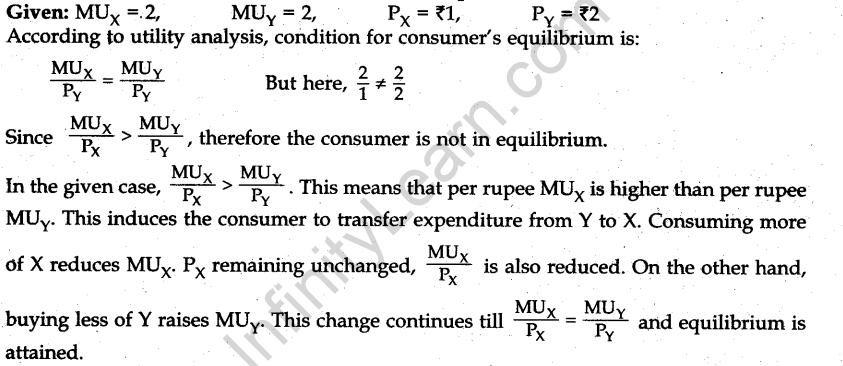
Question. 10 When price of a good rises from Rs 12 per unit to Rs 15 per unit the producer supplies 50 per cent more output. What is the price elasticity of supply? Calculate.
Answer.

Question. 11 Explain the effect of: (a) change in own price and (b) change in price of substitute on demand of a good.
Answer. (a) Change in own price. Other things remaining constant, a change in the price of the commodity leads to a change in the quantity demanded. Graphically, it means movement along the same demand curve. When quantity demanded increases as a result of fall in price of the commodity, it leads to a downward movement (called expansion) along the same demand curve.
On the other hand, an increase in the price of the commodity results in a reduction in the quantity demanded leading to an upward movement on the same demand curve (called contraction).
(b) See Q. 9(a), 2016 (I Delhi).
SECTION B
Question. 20 What is Revenue deficit in government budget?
Answer. Revenue deficit is the excess of government’s revenue expenditure over revenue receipts.
Revenue Deficit- Revenue Expenditure – Revenue Receipts
Question. 22 In an economy an increase in investment by Rs 100 crore led to ‘increase’ in national income by Rs 1000 crore. Find marginal propensity to consume.
Answer.

Question. 29 Find net national product at market price and personal disposable income:

Answer.




